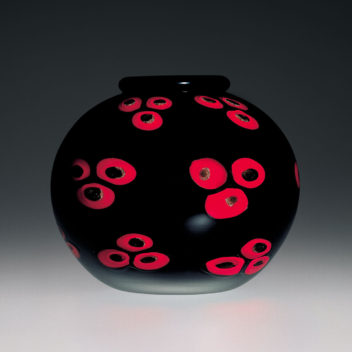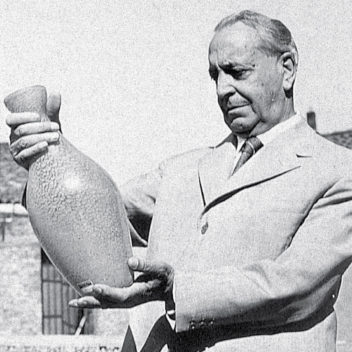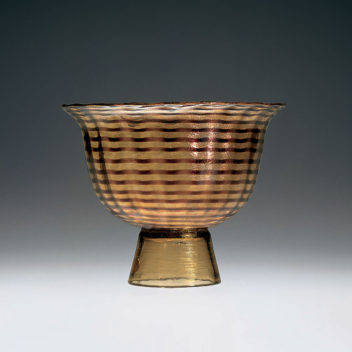
Ercole BarovierA murrine, 1927

Ercole BarovierA murrineVetreria Artistica Barovier, 1927
An amethyst vase decorated with circular red and avventurina murrine set in groups of three.
7 1/4 in. high (18.5 cm)
Exhibitions:
1952, Venice, 26th Biennale Internazionale d’Arte, Historic exhibition of Murano glass;
2000, New York, Venetian Glass, Museum of Arts & Design;
2001, Milan, Murano: Vetri dalla Collezione Olnick Spanu, Spazio Oberdan.
Bibliography and comparative texts:
Gasparetto, 1960, n. 3;
Mostra del Vetro…, 1984, n. 126;
A. Dorigato, 1989, n. 7;
M. Barovier, 1993, n. 79;
M. Barovier, 1999, p. 103;
Olnick Spanu, 2000, n. 5;
Olnick Spanu, 2001, n. 7.

Ercole Barovier 1889–1974
Entrepreneur and designer Ercole Barovier was the son of Benvenuto Barovier. At age 30, he became a partner in his father's company, the Vetreria Artistica Barovier & C. After becoming its artistic director in 1926, he took over its management with his brother. He became sole proprietor in 1936, engineering the fusion between his own glass workshop and the S.A.I.A.R. Ferro-Toso. In 1942, the new company was renamed Barovier & Toso and Ercole maintained artistic direction until 1972. His first major successes date back to the '20s; first with the murrine vessels, then with totally original creations such as the Primavera glass collection of 1929-30. After the 30s, he dedicated himself entirely to experimenting with new multi-colored effects. In addition he perfected the colorazione a caldo senza fusione which he first used in 1935-36 to create the series Crepuscolo, Autunno Gemmato, Marina Gemmata, and Laguna Gemmata. Before World War II, he preferred soft shapes and rather thick materials, whereas in the postwar period his interest turned specifically to the field of traditional techniques, which he continued to reinterpret through his very last creations with the series A Tessere in 1972. In the '50s, his work distinguished itself, both for the vivid quality of its colors as well as for the singularity of the materials noted for the rawness of their surfaces like the barbarici. During the '60s and '70s, he gave new interpretations of his a tessere glass with the Dorici, Caccia, Rotellati, and other series, which were characterized by unusual color combinations.

Vetreria Artistica Barovier 1919–1936
In 1919, Artisti Barovier changed its name to Vetreria Artistica Barovier and several new partners were added. Among them were Ercole Barovier and Nicolò Barovier, Benvenuto Barovier's sons, and Giuseppe Barovier's son Napoleone. In 1926, Ercole and Nicolò Barovier took over the management of the company and both became artistic directors, creating, among other things, sophisticated multicolored vessels a murrine and singular animals in blown glass. After 1932, Nicolò and Ercole Barovier became sole proprietors of the company. Ercole designed many objects that earned the company remarkable success, among them the Primavera series. A tireless creator of new collections and glass textures, Ercole Barovier dedicated himself to perfecting the colorazione a caldo senza fusione, which he began using during the second half of the '30s. In 1936, after the separation from his brother Nicolò, Ercole Barovier became partner of the S.A.I.A.R. Ferro Toso, forming Ferro Toso e Barovier.
Ercole BarovierA murrine, 1927

Carlo ScarpaLattimo, 1929-1930

Carlo ScarpaLattimoMaestri Vetrai Muranesi Cappellin & C., 1929-1930
Vase in lattimo glass, slightly iridized, with handles applied in black pasta vitrea.
Acid stamped:
M.V.M. Cappellin & C., Murano.
5 1/2 in. high (14 cm)
Exhibitions:
2001, Milan, Murano: Vetri dalla Collezione Olnick Spanu, Spazio Oberdan.
Bibliography and comparative texts:
M.V.M. Catalogue, n. 5267;
M. Barovier, 1997, n. 53;
Olnick Spanu, 2001, n. 45.

Carlo Scarpa 1906–1978
Born in Venice, Carlo Scarpa graduated from the Accademia di Belle Arti in Venice in 1926. Soon after his graduation he began work at M.V.M. Cappellin, where he soon replaced Vittorio Zecchin as artistic director. Following the direction laid down by Zecchin, he initially created transparent blown-glass pieces with essential forms, in particular the pieces exemplified by their conic base. Scarpa later designed light glass pieces in brightly colored pasta vitrea, or decorated fenici. Deservedly famous was the refined collection of lattimi decorated with gold or silver leaf, which he presented for the first time in Monza in 1930 together with the canne verticali and millefiori glass works. Giacomo Cappellin closed the workshop in 1932 for bankruptcy, putting an end to the collaboration with Carlo Scarpa. In 1934, Scarpa became the artistic director of Venini & C., where he continued to work through 1947. Alongside Paolo Venini, who often participated in the design of glass, Carlo Scarpa experimented with the vast potential of glass, using and innovating many traditional techniques, by which he created extraordinary modern pieces. After the mezza filigrana glass works came the sommersi, the pasta vitrea inspired by Chinese ceramic motifs, the corrosi, the battuti, the vessels a fasce colorate, a pennellate, the variegati, and the famous multicolored murrine with the surfaces finished at the carving wheel. After World War II, Carlo Scarpa worked almost exclusively as an architect and teacher.

Maestri Vetrai Muranesi Cappellin & C. 1925–1932
M.V.M. Cappellin & C. was founded in 1925 by Giacomo Cappellin after the closing of Cappellin Venini & C. Vittorio Zecchin, a painter from Murano who had worked for Cappellin Venini, continued his collaboration with Cappellin for a short time, designing soffiati, blown glass pieces characterized by delicate colors and pure lines. At the end of 1926, following Zecchin's departure, the young Carlo Scarpa took over the artistic direction of the company. Initially, he proceeded along the course taken by his predecessor, creating lightweight blown pieces with simple geometric forms. These were followed by many collections of refined elegance characterized by various transparent textures and often distinguished by vivid colors. Despite the remarkable success at the 1930 Biennale di Monza, M.V.M. Cappellin & C. was forced to close in January 1932. This was most likely the result of inefficient financial management.
Carlo ScarpaLattimo, 1929-1930

Ercole BarovierAvventurina, 1929-1930

Ercole BarovierAvventurinaVetreria Artistica Barovier, 1929-1930
Avventurina glass vase. Applied double-curved cristallo glass handles decorated a morise.
The vase is a variation of a model found in the primavera glass series.
11 5/8 in. (29.5 cm)
11 3/8″ high (29 cm)
Exhibitions:
2000, New York, Venetian Glass, Museum of Arts & Design;
2001, Milan, Murano: Vetri dalla Collezione Olnick Spanu, Spazio Oberdan.
Bibliography and comparative texts:
A. Dorigato, 1989, n. 20;
F. Deboni, 1996, p. 30;
Olnick Spanu, 2000, n. 6;
Olnick Spanu, 2001, n. 8.

Ercole Barovier 1889–1974
Entrepreneur and designer Ercole Barovier was the son of Benvenuto Barovier. At age 30, he became a partner in his father's company, the Vetreria Artistica Barovier & C. After becoming its artistic director in 1926, he took over its management with his brother. He became sole proprietor in 1936, engineering the fusion between his own glass workshop and the S.A.I.A.R. Ferro-Toso. In 1942, the new company was renamed Barovier & Toso and Ercole maintained artistic direction until 1972. His first major successes date back to the '20s; first with the murrine vessels, then with totally original creations such as the Primavera glass collection of 1929-30. After the 30s, he dedicated himself entirely to experimenting with new multi-colored effects. In addition he perfected the colorazione a caldo senza fusione which he first used in 1935-36 to create the series Crepuscolo, Autunno Gemmato, Marina Gemmata, and Laguna Gemmata. Before World War II, he preferred soft shapes and rather thick materials, whereas in the postwar period his interest turned specifically to the field of traditional techniques, which he continued to reinterpret through his very last creations with the series A Tessere in 1972. In the '50s, his work distinguished itself, both for the vivid quality of its colors as well as for the singularity of the materials noted for the rawness of their surfaces like the barbarici. During the '60s and '70s, he gave new interpretations of his a tessere glass with the Dorici, Caccia, Rotellati, and other series, which were characterized by unusual color combinations.

Vetreria Artistica Barovier 1919–1936
In 1919, Artisti Barovier changed its name to Vetreria Artistica Barovier and several new partners were added. Among them were Ercole Barovier and Nicolò Barovier, Benvenuto Barovier's sons, and Giuseppe Barovier's son Napoleone. In 1926, Ercole and Nicolò Barovier took over the management of the company and both became artistic directors, creating, among other things, sophisticated multicolored vessels a murrine and singular animals in blown glass. After 1932, Nicolò and Ercole Barovier became sole proprietors of the company. Ercole designed many objects that earned the company remarkable success, among them the Primavera series. A tireless creator of new collections and glass textures, Ercole Barovier dedicated himself to perfecting the colorazione a caldo senza fusione, which he began using during the second half of the '30s. In 1936, after the separation from his brother Nicolò, Ercole Barovier became partner of the S.A.I.A.R. Ferro Toso, forming Ferro Toso e Barovier.
Ercole BarovierAvventurina, 1929-1930

Ferro Toso BarovierToso Avventurina, ca. 1936

Toso AvventurinaFerro Toso Barovier, ca. 1936
Ribbed vessel in transparent fumé glass decorated with a spiral in avventurina glass. Glass foot in transparent fumé glass.
Paper label: FTB.
7 in. high. (17.8 cm)
Exhibitions:
2001, Milan, Murano: Vetri dalla Collezione Olnick Spanu, Spazio Oberdan.
Bibliography and comparative texts:
M. Heiremans, 1996, n. 46;
Olnick Spanu, 2001, n. 9.

Ferro Toso Barovier 1936–1939
In 1936, after the separation from his brother Nicolò, Ercole Barovier became partner of the S.A.I.A.R. Ferro Toso, forming Ferro Toso e Barovier. In 1939, it became Barovier Toso & C., and finally, in 1942, its name was changed to Barovier & Toso. Ercole Barovier remained artistic director of the company through 1972 and was succeeded by his son, Angelo, who was already a designer for the company.
Ferro Toso BarovierToso Avventurina, ca. 1936

Carlo ScarpaLattimo, 1929

Carlo ScarpaLattimoMaestri Vetrai Muranesi Cappellin & C., 1929
Amphora-shaped vase in lattimo glass with two applied handles.
The entire surface is decorated with oxidized gold leaf applications.
9 1/2 in. high (24.1 cm)
Exhibitions:
1930, Monza, 4th Esposizione Internazionale delle Arti Decorative
e Industriali Moderne;
1931, Amsterdam, Exhibition of modern Italian glass, ceramic, and artistic lacework, Stedelijk Museum;
2000, New York, Venetian Glass, Museum of Arts & Design;
2001, Milan, Murano: Vetri dalla Collezione Olnick Spanu, Spazio Oberdan.
Bibliography and comparative texts:
Artisti italiani…, 1929; Domus, 1929, April, p. 35; Domus, 1929, October, pp. 30, 31;
Domus, 1930, January, p. 39;
Mostra di vetri…, 1931, p. 21;
M. Karasik, 1989, n.1;
M. Barovier, 1991, nn. 5, 6, pp. 51, 53;
M. Heiremans, 1993, n. 77; F. Deboni, 1996 n. 63; M. Heiremans, 1996,
n. 25;
M. Barovier, 1997, pp. 196, 197;
M. Barovier, 1998 (b), pp. 10, 11;
M. Barovier, 1999, p. 141;
Olnick Spanu, 2000, n. 28;
Olnick Spanu, 2001, n. 46.

Carlo Scarpa 1906–1978
Born in Venice, Carlo Scarpa graduated from the Accademia di Belle Arti in Venice in 1926. Soon after his graduation he began work at M.V.M. Cappellin, where he soon replaced Vittorio Zecchin as artistic director. Following the direction laid down by Zecchin, he initially created transparent blown-glass pieces with essential forms, in particular the pieces exemplified by their conic base. Scarpa later designed light glass pieces in brightly colored pasta vitrea, or decorated fenici. Deservedly famous was the refined collection of lattimi decorated with gold or silver leaf, which he presented for the first time in Monza in 1930 together with the canne verticali and millefiori glass works. Giacomo Cappellin closed the workshop in 1932 for bankruptcy, putting an end to the collaboration with Carlo Scarpa. In 1934, Scarpa became the artistic director of Venini & C., where he continued to work through 1947. Alongside Paolo Venini, who often participated in the design of glass, Carlo Scarpa experimented with the vast potential of glass, using and innovating many traditional techniques, by which he created extraordinary modern pieces. After the mezza filigrana glass works came the sommersi, the pasta vitrea inspired by Chinese ceramic motifs, the corrosi, the battuti, the vessels a fasce colorate, a pennellate, the variegati, and the famous multicolored murrine with the surfaces finished at the carving wheel. After World War II, Carlo Scarpa worked almost exclusively as an architect and teacher.

Maestri Vetrai Muranesi Cappellin & C. 1925–1932
M.V.M. Cappellin & C. was founded in 1925 by Giacomo Cappellin after the closing of Cappellin Venini & C. Vittorio Zecchin, a painter from Murano who had worked for Cappellin Venini, continued his collaboration with Cappellin for a short time, designing soffiati, blown glass pieces characterized by delicate colors and pure lines. At the end of 1926, following Zecchin's departure, the young Carlo Scarpa took over the artistic direction of the company. Initially, he proceeded along the course taken by his predecessor, creating lightweight blown pieces with simple geometric forms. These were followed by many collections of refined elegance characterized by various transparent textures and often distinguished by vivid colors. Despite the remarkable success at the 1930 Biennale di Monza, M.V.M. Cappellin & C. was forced to close in January 1932. This was most likely the result of inefficient financial management.